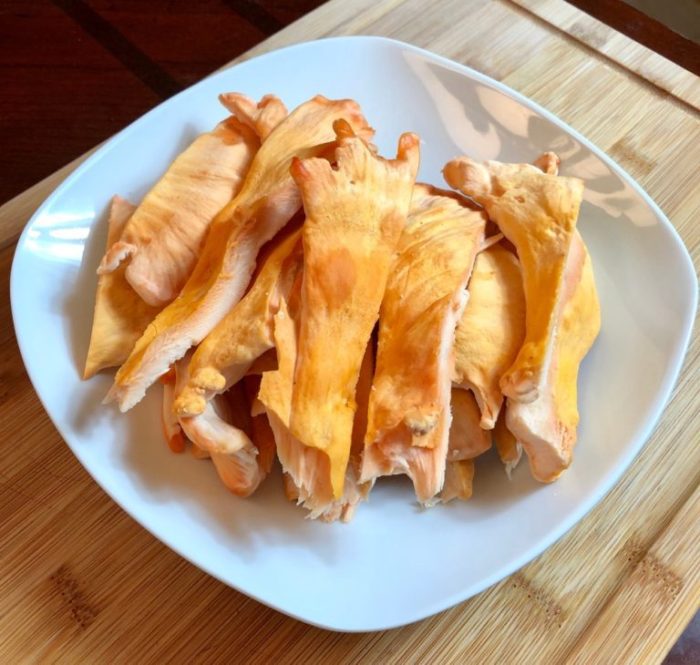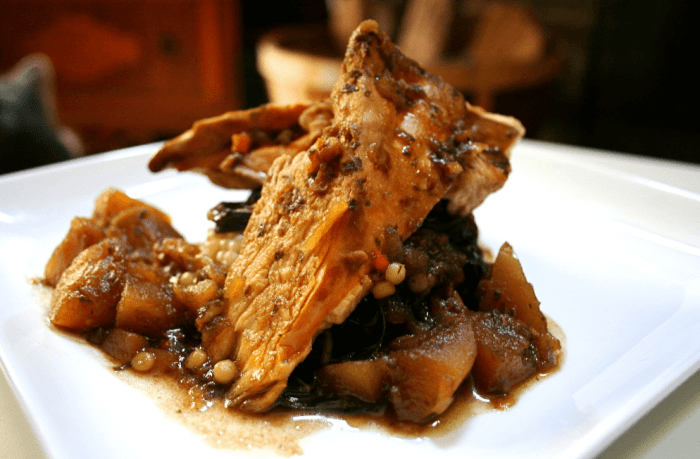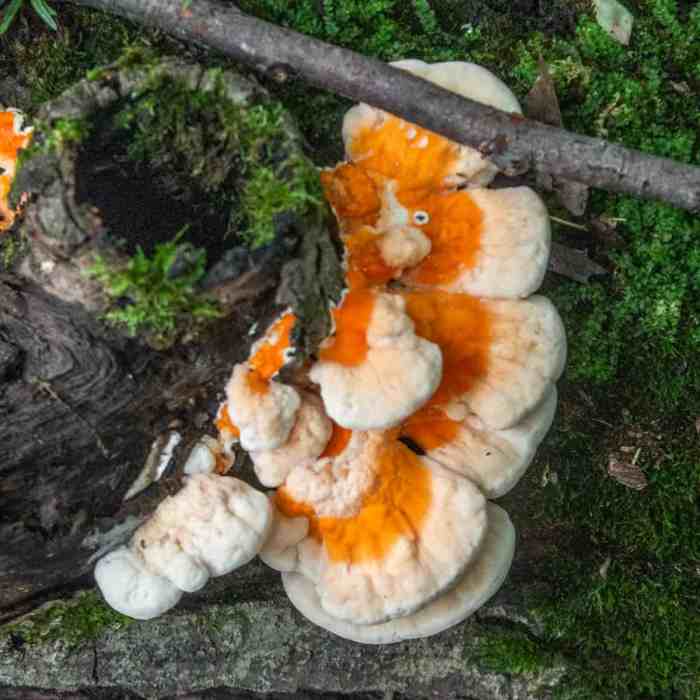
Embark on a culinary adventure with our comprehensive guide to chicken of the woods recipe. From its nutritional wonders to tantalizing flavor profiles, discover the secrets of this extraordinary forest delicacy.
With its vibrant colors and succulent texture, chicken of the woods is a culinary treasure waiting to be explored. Our recipe collection and expert insights will guide you through every step, from foraging to preparation, ensuring a delectable experience with every bite.
Ingredients and Nutritional Information
Chicken of the woods is a versatile mushroom that can be used in a variety of dishes. It has a meaty texture and a slightly nutty flavor, making it a popular choice for vegetarians and vegans alike.
The most common ingredients used in chicken of the woods recipes include:
- Chicken of the woods mushrooms
- Olive oil
- Garlic
- Onion
- Salt and pepper
Chicken of the woods is a good source of protein, fiber, and vitamins. A 100-gram serving of cooked chicken of the woods contains:
- 3 grams of protein
- 2 grams of fiber
- 20% of the recommended daily intake of vitamin C
- 10% of the recommended daily intake of potassium
- 5% of the recommended daily intake of iron
Chicken of the woods is a low-calorie food, making it a good choice for people who are trying to lose weight or maintain a healthy weight.
Cooking Methods and Techniques

Chicken of the woods can be prepared using various cooking methods, each imparting unique flavors and textures. Sautéing, roasting, and grilling are popular techniques that showcase the mushroom’s versatility.Before cooking, it’s essential to clean the chicken of the woods thoroughly, removing any dirt or debris.
Slice the mushroom into manageable pieces for even cooking. Marinating the slices in a flavorful blend of herbs, spices, and oil can enhance their taste.
Sautéing
Sautéing involves cooking the chicken of the woods in a pan with a small amount of oil or butter over medium heat. This method allows the mushroom to develop a crispy exterior while remaining tender on the inside.
Roasting
Roasting chicken of the woods in the oven is another excellent way to bring out its earthy flavors. Preheat the oven to 400°F (200°C) and toss the mushroom slices with olive oil, salt, and pepper. Roast for 15-20 minutes, or until golden brown and slightly crispy.
Grilling
Grilling chicken of the woods over an open flame adds a smoky and charred flavor. Brush the mushroom slices with olive oil and season them to taste. Grill over medium heat for 5-7 minutes per side, or until tender and slightly charred.
Flavor Profiles and Seasonings
Chicken of the woods possesses a unique and multifaceted flavor profile, offering a meaty, umami-rich taste with hints of nuttiness and a slightly peppery kick. This versatility allows for a wide range of seasoning options to enhance and complement its inherent flavors.
Herbs such as thyme, rosemary, and sage pair exceptionally well with chicken of the woods, adding earthy and aromatic notes. Spices like paprika, cumin, and chili powder introduce warmth and a touch of smokiness. For a zesty twist, consider incorporating lemon zest or juice into your seasoning blend.
Sauces
Sauces can further elevate the taste of chicken of the woods, adding moisture and richness. Creamy sauces, such as béchamel or Alfredo, provide a luxurious complement to the mushroom’s meaty texture. Alternatively, a simple pan sauce made with butter, garlic, and white wine offers a classic and flavorful accompaniment.
If you’re looking for a unique and flavorful mushroom dish, try the chicken of the woods recipe . This edible mushroom has a texture and flavor similar to chicken, making it a great vegetarian or vegan alternative. Whether you’re an experienced chef or a novice in the kitchen, this recipe is easy to follow and sure to impress your taste buds.
Recipe Variations and Pairings

The versatility of chicken of the woods makes it a suitable ingredient for a wide range of culinary creations. From simple sautéed dishes to complex stews and soups, the possibilities are endless. Here are some variations to inspire your cooking adventures:
Sautéed Chicken of the Woods:This simple yet flavorful preparation involves pan-frying the mushrooms with butter or olive oil. Season with salt, pepper, and herbs of your choice for a quick and satisfying meal.
Chicken of the Woods Stew:Combine the mushrooms with vegetables like carrots, celery, and onions in a flavorful broth. Simmer until tender for a hearty and comforting stew.
Chicken of the Woods Soup:Blend the cooked mushrooms with vegetable or chicken broth to create a creamy and umami-rich soup. Serve with crusty bread or crackers.
Pairings
Chicken of the woods pairs well with various ingredients, enhancing their flavors and textures:
- Vegetables:Sautéed or roasted vegetables like zucchini, bell peppers, and onions complement the earthy flavor of the mushrooms.
- Grains:Quinoa, rice, or pasta provide a starchy base to balance the richness of the mushrooms.
- Meats:Chicken, beef, or pork can be paired with chicken of the woods for a protein-packed meal.
Health Benefits and Considerations: Chicken Of The Woods Recipe

Chicken of the woods is not only a culinary delight but also a potential source of health benefits. Its rich antioxidant content, including ergothioneine and phenols, has been linked to various health-promoting effects.
Antioxidant Properties, Chicken of the woods recipe
- Ergothioneine, a unique antioxidant found in chicken of the woods, has been shown to protect cells from oxidative damage and inflammation.
- Phenols, another class of antioxidants present in this mushroom, contribute to its overall antioxidant capacity and may reduce the risk of chronic diseases associated with oxidative stress.
Anti-inflammatory Properties
Chicken of the woods contains compounds that exhibit anti-inflammatory properties. These compounds may help reduce inflammation throughout the body, potentially providing benefits for conditions such as arthritis and inflammatory bowel disease.
Safety Considerations
While chicken of the woods is generally considered safe to consume, certain precautions should be taken:
- Proper identification: It is crucial to correctly identify chicken of the woods before consuming it. Seek guidance from experienced foragers or consult reliable resources to ensure accurate identification.
- Foraging practices: When foraging for chicken of the woods, choose specimens from unpolluted areas away from roads or industrial sites.
- Cooking: Chicken of the woods should be thoroughly cooked before eating to reduce the risk of gastrointestinal upset or allergic reactions.
- Allergies: Some individuals may be allergic to chicken of the woods or other mushrooms. If you experience any adverse reactions, discontinue consumption and seek medical advice.
Last Word

As you delve into the world of chicken of the woods recipe, you’ll uncover a culinary tapestry of flavors and textures. Experiment with our diverse recipes, explore the mushroom’s versatility, and unlock the hidden culinary gems that await in the heart of nature’s pantry.
Remember, foraging for chicken of the woods requires caution and proper identification. Always consult with experienced foragers or refer to reliable resources to ensure a safe and rewarding culinary journey.
Detailed FAQs
Can chicken of the woods be eaten raw?
No, chicken of the woods should not be consumed raw. Cooking helps to break down the mushroom’s tough texture and release its full flavor.
What does chicken of the woods taste like?
Chicken of the woods has a mild, earthy flavor with a slightly sweet undertone. Its texture is meaty and tender, resembling chicken.
Is chicken of the woods a good source of protein?
Yes, chicken of the woods is a good source of protein, providing approximately 10 grams per 100 grams of cooked mushroom.



